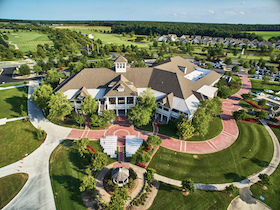It Takes a (Virtual) Village to Stay in Your Home
Category: Retirement Planning
Update: September, 2013. A year later the Shoreline Village is alive and well. Definitely beginning to make an impact on the Shoreline community, although perhaps slower than they would like. In 2013 they were sufficiently far along to hire an executive director, a step the board felt strongly they had to take. Unfortunately that didn’t work out, and they are now searching for a new director. Meanwhile they are getting good publicity with many public programs they are putting on in the towns of their target market – East Haven, Branford, Guilford, and Madison. Looks like the hard work of the founders is going to pay off!
May 29, 2012 — The Retirement Village Movement – For Those Who Really, Really Don’t Want to Leave Home
Are you one of the people who wants to stay living where you do now? For whom the idea of moving to an active community, over 55+ community, or assisted living is just about the worst idea you ever heard? If so, you will probably be interested in the so-called “Retirement Village” Movement. This idea, which started with Boston’s Beacon Village in 2001, features cooperative societies that create a virtual support network to help with all of the life tasks that get in the way of staying in your home as you age. We recently attended an informational meeting for a new village being created in Branford, Connecticut, the Shoreline Village CT. This will report on that meeting and why you might want to know more about this movement.
The meeting we attended in Branford was hosted in a lovely condo in Branford. Dr. Randy Reinhold, one of Shoreline Village’s 8 founding board members, captured the spirit of the movement with this opening statement: “I love my home in Branford, and I never want to leave it”. The thought clearly struck a chord with the 25 people gathered to learn more about this new village.
For the next hour Reinhold explained the village concept, outlined Shoreline Village’s progress in getting established, and answered questions from the audience. He explained that there are more than 200 villages spread across the country at this time, with more on the drawing board. The goal of the village movement is to permit people to remain independent longer by providing resources to help with situations that might otherwise force a move to another kind of facility.
How does a Village differ from a traditional retirement or 55+ community?
Here are some of the key concepts associated with these virtual retirement villages, including how they differ from traditional retirement communities:
– There is no building or central community. The village is virtual – it exists in its cooperative members, its staff, and the resources it can provide to make retired life easier, richer, and allow its members to remain independent longer as they age
– Village members pay a fee to avail themselves of the Village network resources
– A village usually offers the following services to its members:
- Door to door, personal transportation for shopping, medical, recreation
- Lists of vetted suppliers for a range of suppliers such as home health care aides, handymen, computer geeks, plumbers, etc. Based on the village’s purchasing power, it is often able to negotiate discounts for members
- Help and advice with dealing with minor crises concerning health, living, aging, etc.
- Education and advice about medical and other issues
- Social and cultural opportunities. Those might include meeting people through volunteering; organized trips to nearby cities, plays or concerts; or other get togethers.
How do you create a successful village
The Shoreline Village, a 501-3c non-profit organization, plans on getting a majority of its members from Branford, the town with the largest number of seniors on this part of Shoreline (coastal communities near New Haven). Residents of neighboring communities like East Haven and Madison are also expected to join.
Based on the Board’s extensive research in setting up the Shoreline Village, it has determined that it will need 150 members to be viable. That is the minimum number that collectively, along with a modest amount of fund raising, will provide enough revenue to pay for a full time Director and part time assistant. Although volunteers will provide the lion’s share of services to its members, the Shoreline Village leadership believes that without a paid professional to manage the resources and provide leadership it will not be able to adequately fulfill its mission and retain happy members. While there are villages that rely purely on volunteer staff, this Board’s research found that the volunteer model is often in chaos mode – struggling for leadership and for funds.
Organizers striving to create the Shoreline Village
According the the Village to Village Network, an association that strives to promote the village movement, there are 89 retirement villages operating in the U.S., Canada, Australia, and the Netherlands, with another 123 in planning stages in this country. You can see a map on their website of all of the existing and planned communities.
Getting any organization off the ground from nothing is a challenging, difficult enterprise. We spoke with Dr. Reinhold about the progress the Shoreline Village is making, and many of his comments are summarized below:
– There are neighboring villages in Connecticut in various stages of planning, including
Cambridge at Home, East Rock Village, New Canaan, and a planned village in Guilford. Some of them have attracted sizable grants or donations, which makes things easier
– Shoreline Village is trying now to secure $100 membership reservations from prospective members. When they feel they have 100 solid commitments, they will start recruiting an executive director for a potential October 1 start
– Reinhold gave a few examples of the benefits of participating in a retirement village. One was of an elderly man whose wife became seriously ill. Thanks to the all-around assistance from the village, they were both able to cope with the emergency and eventually resume living in their home
– Once the village is set up it will arrange services and make calls to make life easier for its members, who just have to dial an 800 number for help. Questions are rarely new to the director, who usually also has a part time assistant
– Joining the village is far, far cheaper than even a short-term stay in an assisted living or nursing facility
– Villages are sometimes able to arranges deals that provide savings on health care, hospitals, or visiting nurse associations
– The value of the social aspect of a being a member of a retirement could be very important, and should not be discounted
– Reinhold believes there could be 1000s of villages in the next 20 years. He personally believes assisted living is slowing down, and feels to him like being warehoused.
– Most important, a retirement village often makes the difference between living in your home – or going to a nursing home
Objections
So far the retirement village sounds very good, for those who are sure they want to live in their own homes as long as possible. The Shoreline Village has so far received about 25 deposits, a bit slower than expected, and we asked Reinhold why he thought that was:
– So far the biggest objection is – “We’re not yet ready.” Although people want the village to be ready when they need it, the human tendency is to wait. We see the same phenomenon for independent living and CCRCs – nobody seems to want to move in until the very last moment
– Folks want to know where the village is – it takes a little explaining that it is an organization and a group of resources rather than a place
– There is concern about what they get for their money ($1000 a year for a couple and $800 for an individual). Transportation, mostly provided by vetted volunteers, is the most tangible benefit. But people have trouble seeing how the village could help the solve many of their ongoing issues and problems that increased age make more difficult
– He believes that Shoreline Village will succeed in getting to the starting line in the near future. It will launch as originally planned, expand to a greater geographical area, merge with another village, or just take longer to get going.
– Lastly, Reinhold re-emphasized why he believes the executive director model is superior than the all-volunteer model. After all, he pointed out, “Volunteers take vacations. What the village needs to succeed is consistency and the ability to respond when needed.”
Are you interested in the village concept – and staying in your home as long as possible?
If so you should check out the Village Network map and the villages nearest you. There are also co-housing, Naturally Occurring Retirement Communities (NORCs), and other types of cooperatives that might appeal to you. If you are interested in starting a village in your community, by all means contact the Village Network, who could assist you. We wish the Shoreline Village CT great success, and compliment their organizers for the hard work and skill they have put into getting it off the ground.
For further reference
The Village Network
Shoreline Village CT
Beacon Hill and other Retirement Village options
Cohousing.org
Cooperative Housing Movement Grows
A related phenomenon are the senior cooperative housing complexes that are taking off in the Midwest. In these cooperatives the residents own the community, which offers many advantages. But unlike the village movement, you do not continue to live in your own home. Here is the USA Today article on senior cooperative housing complexes.
Comments? Does the retirement village idea appeal to you? Please share your thoughts in the Comments section below. If there is sufficient interest we will explore the idea further, including more about cohousing and other cousins of this idea.






Comments on "It Takes a (Virtual) Village to Stay in Your Home"
Holly says:
John - Please do continue to provide information on this concept as well as coj-housing. I lived in the Lyons CO co-housing development a few years ago and would consider it to be an option in the future, but the Virtual Village is another great idea! Babby Boomers are seeking different choices as we age, so we need the education on what the options are or could be! Thanks much -
Mad Monk says:
I second Holly's request. Please include and new Virtual Villages in your database. Also, I have saved this and other interesting articles in various hotmail folders specific to the topic. As I have seen in my life, we males (in general, definitley not exclusively) appear to be less needing of social contact than the other half of our species. I recognize that my wife is very much more "social" than I am. For those who seek such, without perhaps the gated communities or other exclusively 55+ residences, this could be a great alternative. We will be looking for them in WA & OR.
sandy says:
This sound very interesting. It is a good idea. Love to see more on the co-op approach to retirement living. Canada has a great program for their seniors. Love to see this across the States.
Dick says:
The mad monk has a point.For those of us who enjoy the beauty and solitude of the mountains, a virtual villege could be a solution to the prospect of moving down to the big city. I've observed that nature's beauty is often more therapeutic than the 'downsizing' that comes from assisted living. It's a 'quality of life' thing.
Jennifer says:
We have virtual villages her in DC. Capitol Hill has a very successful one and now one is forming in Georgetown which will encompass where I live now in NW DC. Bethesda Maryland alao has a virtual village formed. It really works. Vendors offer discounts and then once services are used they are critiqued for the other village members. We have a good ratio of volunteers to those who need assistance. Looks like a good way to "age in place." Many people do not prefer to be shuttled to old folks and over 55 developments. This system allows you to age in place--even do without a car, as many volunteers drive the village members whereever they need to go. We had the directors of the virtual village in Northwest DC come to our co-op to speak to our Member Owners--about 40 percent of which are retirees.
Admin says:
Our friend Gail Hinand alerted us to an article in USA Today about a related phenomenon, senior cooperative housing complexes, that are taking off in the Midwest. We will start adding these to our database as we find out about them, because they seem quite interesting. In these cooperatives the residents own the community, which offers many advantages. But unlike the village movement, you do not continue to live in your own home.
http://www.usatoday.com/money/economy/housing/story/2012-05-22/senior-cooperative/55502230/1